A new highly efficient and low production cost light emitting diode (LED) that could "potentially revolutionise lighting technology," has been developed. Zhibin Yu, an assistant professor of Industrial and Manufacturing Engineering at Florida State University (FSU) described the new LED making process in the journal Advanced Materials.

More and more organisations and people are using LED for lighting to cut energy bills. According to the US Department of Energy, residential LED lighting uses about 75 per cent less energy than regular incandescent lighting. Unfortunately the LED bulbs are quite a bit more expensive than we have got used to spending for these consumable items. Also, if you can find cheaper LED bulbs, they may not produce the light hues you like.
There are currently practical barriers to LEDs getting much cheaper, as making them is said to be a rather complicated process. As New Electronics reports "most LED materials require engineers to put four or five layers of material on top of each other to create the desired product or effect." The new LEDs developed at FSU only need one layer.
A combination of organic and inorganic materials is used in the new process. The key material dissolves easily in water and can be applied like paint. It shines in blue, green or red light. Sounding rather pleased with his development, assistant professor Yu said "It can potentially revolutionize lighting technology. In general, the cost of LED lighting has been a big concern thus far. Energy savings have not balanced out high costs. This could change that."

Yu's research has been recognised by the US government which has given him a National Science Foundation award to help in further development. He is also looking into stretchable, active-matrix organic LED displays.













